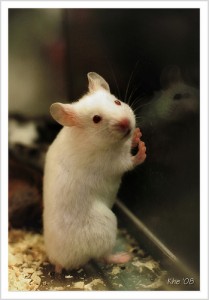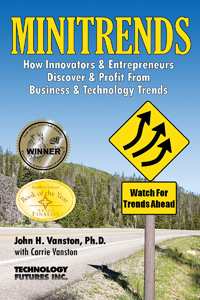A Longer Lifespan with Science and Work
by Steve O'Keefe on December 10, 2010
 Since I was born, average life expectancy in the U.S. has increased by 10 years, from about 68 years to 78 years. In the next decade, it will increase by another 20 years, according to futurist Ray Kurzweil, who predicts that by the year 2019, the life expectancy of someone born in the U.S. will be over 100 years.
Since I was born, average life expectancy in the U.S. has increased by 10 years, from about 68 years to 78 years. In the next decade, it will increase by another 20 years, according to futurist Ray Kurzweil, who predicts that by the year 2019, the life expectancy of someone born in the U.S. will be over 100 years.
A celebrated M.I.T. scientist, Kurzweil has embarked upon a dietary regimen designed to improve his longevity to the point where “life expectancy is no longer a viable term in relation to intelligent beings.” Until recently, the dominant method of life extension has been calorie restriction. If you can cut your daily calories in half without impacting your vitality, studies show you will live considerably longer.
Last week, another breakthrough offered hope for an engineered end to aging. The forever elusive “fountain of youth” is now pumping out telomerase. Telomerase is an enzyme that keeps telomeres from unravelling. Ewen Calloway, a biotech writer for the journal Nature, which published this new Harvard study, explains the significance of telomeres:
Chromosomes have caps of repetitive DNA called telomeres at their ends. Every time cells divide, their telomeres shorten, which eventually prompts them to stop dividing and die. Telomerase prevents this decline in some kinds of cells, including stem cells, by lengthening telomeres…
In the Harvard study conducted by the Dana-Farber Cancer Institute and Harvard Medical School, mice were genetically engineered with dormant telomerase, resulting in their rapid and premature aging. Feeding the mice a chemical called 4-OHT reactivated telomerase production, and the mice were remarkably restored to a normal age.
There is hope that telomerase could be used to stimulate the growth of neurons, restoring vitality to the worn-out brains and other organs. However, there’s a catch. Tiffany Kaiser at DailyTech delivers the bad news:
While this therapy is ideal for mice, it will be challenging to translate this type of treatment to humans because slowing the aging process this way could increase the risk of cancer in humans. Mice have the ability to create telomerase throughout the span of their lives, but telomerase eventually discontinues in humans in order to stop cells from overpopulating and possibly turning into cancerous cells.
The promise of the Harvard study is that it shows a reverse in aging, not just a halt to aging. The problem is that it did not extend the lives of the mice one bit; it merely returned them to a normal longevity. Kyle Munkittrick at Discover is also skeptical of the translation of this breakthrough to humans:
It still remains to be seen if telomerase treatments can delay normal aging, reverse normal aging, or extend life in any way in mice. From there scientists have to then figure out what side-effects there are, why those side-effects occur, and then somehow translate the results to human beings. [Emphasis his.]
Perhaps telomerase is not the wonder drug that will keep us alive indefinitely. But something is working to expand our life expectancy, and it might be work. In their new book, MINITRENDS, futurist John H. Vanston and his daughter, Carrie Vanston, note with some surprise that the one trait that links successful entrepreneurs is “exceptionally good health.” Which begs the question, which came first, the health or the work?
Jeannine Stein reports for the Los Angeles Times on a study funded by the National Institute on Aging into the effects of employment on the health of retirees:
The researchers coined the term ‘bridge employment’ to describe the transition period between full-time work and full-time retirement, in which people work part time, are self-employed or temporarily employed. Men and women in that bridge employment category reported fewer major diseases and functional limitations compared with those who were in full retirement.
John and Carrie Vanston devote a significant portion of MINITRENDS to exploring the business opportunities for entrepreneurs resulting from life extension. For some employers, it simply means a larger pool of relatively low-cost, experienced workers. Will other countries be insourcing their busy work to our senior citizens?
The Vanstons also see business opportunities in retooling older workers with modern skills. Already, many retirement homes are locating near universities or on college campuses, to give seniors ready access to both the classes and the culture available from the publicly-funded centers of learning.
As many of us face the prospects of living to be 100 years old, it is comforting to know that those later years can be profitably and pleasurably employed providing valuable services to others. Science will continue to improve our ability to work in our later years, and the exciting work of entrepreneurship will continue to keep us young!
STEVE O’KEEFE
News Editor, Minitrends Blog
Source: The Age of Spiritual Machines, by Ray Kurzweil, pp. 208, 280
Source: “Telomerase reverses ageing process,” Nature, 11/28/10
Source: “Harvard Scientists Reverse Signs of Aging in Mice,” DailyTech, 11/29/10
Source: “Another Tiny, Exciting Step Toward Life-Extension,” Discover, 11/29/10
Source: “Considering retirement? Working might keep you healthier,” Los Angeles Times, 11/14/10
Photo by be_khe (Giang Ho Thi Hoàng), used under its Creative Commons license.
Comments
Got something to say?













